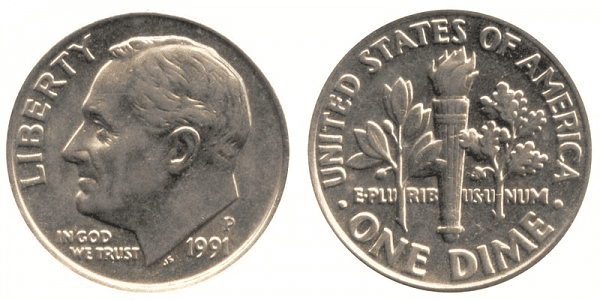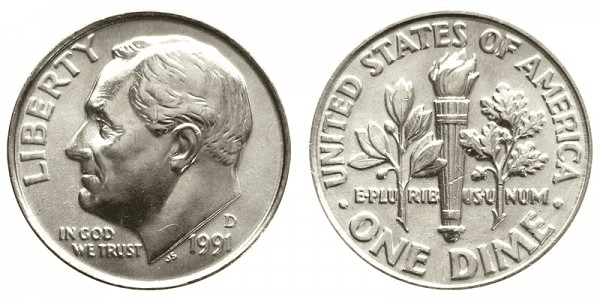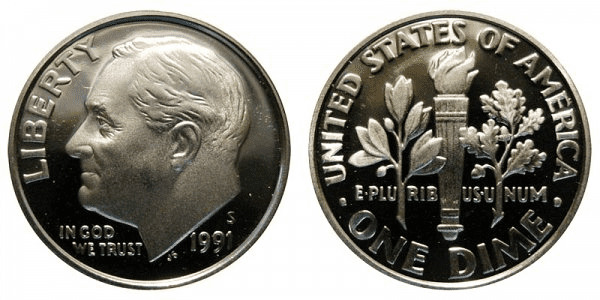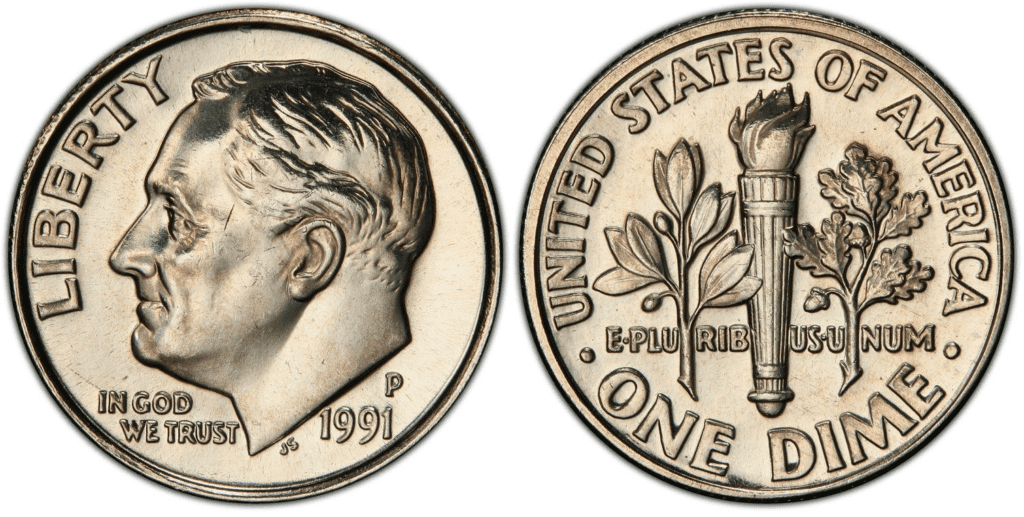What Is the 1991 Roosevelt Dime Made Of?
Since it first went into circulation in 1946, the Roosevelt Dime has served as a continual reminder of President Franklin D. Roosevelt’s support for the March of Dimes and his efforts to eradicate polio. When Congress asked for a new dime in 1945, Chief Engraver John Sinnock created the design. Sinnock’s creation debuted in 1946, replacing the older Winged Liberty Dime.
The coin’s obverse features a bust of President Roosevelt looking to the right. The words “LIBERTY” and “IN GOD WE TRUST” can be found in the right field and margin. It is possible to make out Sinnock’s initials and the year of mintage to the lower left of Roosevelt’s bust. The flame, which represents liberty, is the main image on the coin’s reverse.
On either side of the flame, only one cluster of olive branches exists. “E PLURIBUS UNUM” is written in the gap between each branch and the flame. Above and below the image are the words “ONE DIME” and “UNITED STATES OF AMERICA,” respectively.
Roosevelt Dimes were made of 75% copper and 25% nickel after 1965 when they ceased to include any silver. 1991 dimes weigh 2.27 grams and measure 17.9 mm in diameter. Reeding may be seen on the coin’s edge.
Despite being one of the longest-lasting currency series in the United States, Roosevelt dimes haven’t attracted as much interest from coin collectors as other coin types. This might be partially due to the absence of significant rarity in the series, save for a few variants or low-mintage coins.
In 1991, the Cold War, which had begun in 1947, ended. A coalition force of 34 nations with UN approval attacked Iraq after the demise of the Soviet Union; this battle later came to be known as the Gulf War. This year also saw the beginning of the Yugoslav Wars. In the same year that Nirvana’s renowned “Nevermind” album was released, the first website, “info.cern.ch,” went live. 1991 also signaled the start of Apartheid’s demise.
1991 Roosevelt Dime Varieties
1991 P Roosevelt Dime
Year of minting: 1991
Face Value: $0.10
Composition:75% Copper and 25% Nickel
Total Weight: 2.27 grams
Diameter: 17.91 millimeters
Thickness: 1.35 millimeters
Edge: 115 Reeds
Minted in: Philadelphia
Mint Quantity: 927,220,000

1991 D Roosevelt Dime
Year of minting: 1991
Face Value: $0.10
Composition:75% Copper and 25% Nickel
Total Weight: 2.27 grams
Diameter: 17.91 millimeters
Thickness: 1.35 millimeters
Edge: 115 Reeds
Minted in: Denver
Mint Quantity: 601,241,114

1991 S Roosevelt Dime
Year of minting: 1991
Face Value: $0.10
Composition:75% Copper and 25% Nickel
Total Weight: 2.27 grams
Diameter: 17.91 millimeters
Thickness: 1.35 millimeters
Edge: 115 Reeds
Minted in: San Francisco
Mint Quantity: 2,867,787

List Of 1991 Roosevelt Dime Errors
Full Band 1991 Roosevelt Dime

In addition to circulation wear, many series, including Roosevelt Dimes, are assessed for particular traits denoted by specific grading marks. In the instance of the Roosevelt Dime, the precise grade-related designation in question, Full Bands refers to the horizontal twin bands that can be seen on the torch that lights the reverse of this well-known coin.
The torch is flanked on either side by an oak tree and an olive branch, which collectively represent strength, peace, and freedom. The design by sculptor-engraver John R. Sinnock has appeared on many billions of Roosevelt Dimes since 1946, but only a small portion of them do so in the way that Sinnock intended. As is typically the case with coins, strike faults limit how complete the design is on several of these pieces. One of the areas of the torch that is most prone to missing information is the bands, which is especially obvious on copies of business-strike samples that have been distributed.
Mint condition examples of 1991 Roosevelt Dimes with this distinction can be worth between $40 and $2,150.
Miscellaneous Errors
With so many coins produced each year, a few mistake coins will inevitably end up in circulation.
Even though there aren’t any widely acknowledged mistakes for this mintage year, there are still a few very common errors to watch out for. Off-center strikes can cost between $10 and $20, while clipped planchet coins might cost around $30. 1990 Roosevelt Dimes missing their clad layers are worth about $20, whereas broadstrike errors are worth slightly less, between $5 and $10.
How Much Is 1991 Roosevelt Dime Worth Today?
The 1991 Dime’s face value is worth five times more than its melt value, which is only $0.024 due to the absence of precious metal in the coin, as any silver content has been removed.
The following table lists the 1991 dime values:
| Coin | MS65 | PR65 |
| 1991 P Roosevelt Dime | $2.28 | – |
| 1991 D Roosevelt Dime | $2.28 | – |
| 1991 S Roosevelt Dime Proof | – | $4.52 |
How Does The Grading System Work?
The Sheldon Scale is used by numismatists to provide a numerical value to coins. The Sheldon Scale goes from poor (P-1) to perfect mint state (P-1) (MS-70). Coins were originally evaluated using words to reflect their condition (Good, Fair, Excellent, Etc.). Unfortunately, coin collectors and dealers had different ideas about what each of these terms represent.
Professional numismatists joined together in the 1970s and established coin grading standards. These numismatists now assign grades at key places on the seventy-point scale, using the most regularly utilized numeric points in conjunction with the original adjective grade. The following are the most common coin grades:
- (P-1) Poor – Indistinguishable and probably damaged; if used, must have a date and mintmark; otherwise, rather battered.
- (FR-2) Fair – Nearly smooth, but without the damage that a coin graded Poor often possesses. The coin must have enough detail to be identified.
- (G-4) Fair – Inscriptions have merged into the rims in some areas, and important elements have been mostly erased.
- (VG-8) Very Good- A little weathered, but all of the primary design elements are visible, albeit faintly. There is little if any, central detail left.
- (F-12) Good – The item is very worn, yet the wear is even, and the overall design details stand out clearly. Rims are almost completely isolated from the field.
- (VF-20) Very Fine – Moderately weathered, with some finer features still visible. The motto or all letters of LIBERTY are readable. Both sides of the coin have entire rims that are separated from the field.
- (EF-40) Extremely Fine – Gently used; all gadgets are visible, and the most important ones are bold. The finer details are bold and clear, however, light wear may be seen.
- (AU-50) Uncirculated – Slight evidence of wear on the coin’s design’s high points; may have contact marks; eye appeal should be adequate.
- (AU-58) Uncirculated Choice – Slight traces of wear, no severe contact marks, almost full mint shine, and great eye appeal.
- (MS-60) Mint State Basal – Strictly uncirculated; no indication of wear on the coin’s highest points, but an unsightly coin with reduced luster, visible contact marks, hairlines, and other flaws.
- (MS-63) Mint State Acceptable – Uncirculated, but with contact scratches and nicks, little reduced shine, but otherwise appealing appearance. The strike is weak to average.
- (MS-65) Mint State Choice – Uncirculated with great mint shine, very little contact blemishes, and exceptional eye appeal. The strike is unusually severe.
- (MS-68) Mint State Premium Quality – Uncirculated with superb luster, no obvious contact marks to the naked eye, and exceptional eye appeal. The strike is quick and appealing.
- (MS-69) Almost Perfect Mint State – Uncirculated with perfect brilliance, a sharp and appealing strike, and extremely good eye appeal. A near-perfect coin with minor imperfections in the planchet, strike, and contact markings (seen only under 8x magnification).
- (MS-70) Mint State Perfect – Under 8x magnification, there are no tiny imperfections discernible; the strike is crisp, and the coin is perfectly centered on a beautiful planchet. Rarely seen on a coin, this coin is bright and whole, with original luster and exceptional eye appeal.
Where To Buy Or Sell 1991 Roosevelt Dime?
Due to their lack of intrinsic metal worth, the bulk of 1991 Dimes are sought after by new collectors and those who treasure the nostalgic nature of the mintage year. Therefore, internet markets like eBay are the greatest venues to purchase and sell 1991 dimes. Roosevelt dime specimens that cost extra, such as errors or samples from a high-quality mintage, can be bought and sold on specialised websites like Vcoins. If your coin has been confirmed as a ‘full band’ example, selling with a recognized auction house is advised.
FAQs
How much does a 1991 dime weigh?
1991 Roosevelt dimes are very light, weighing just 2.27g.
Who is on the 1991 dime?
President Roosevelt is featured on the 1991 Dime. From 1933 until his passing in 1945, Franklin Delano Roosevelt, also known by his initials FDR, was a politician and attorney from the United States. He was the 32nd president of the country.
Is a 1991 dime silver?
There is no silver content in a 1991 Dime instead it is comprised of a 75% Copper and 25% Nickel composition.
